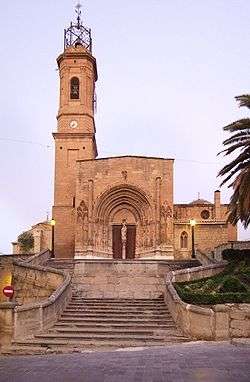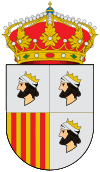Caspe
| Caspe/Casp | |||
|---|---|---|---|
| Municipality | |||
|
Colegiate church of Santa Marya la Mayor. | |||
| |||
 Caspe/Casp Location in Spain | |||
| Coordinates: 41°14′N 0°2′W / 41.233°N 0.033°W | |||
| Country |
| ||
| Autonomous community |
| ||
| Province | Zaragoza | ||
| Comarca | Bajo Aragón-Caspe/Baix Aragó-Casp | ||
| Government | |||
| • Mayor | Pilar Herrero Poblador | ||
| Area | |||
| • Total | 503.33 km2 (194.34 sq mi) | ||
| Elevation | 150 m (490 ft) | ||
| Population (2009) | |||
| • Total | 9,728 | ||
| • Density | 19/km2 (50/sq mi) | ||
| Demonym(s) | Caspolinos | ||
| Postal code | 50700 | ||
| Website | Official website | ||
Caspe (Spanish: [ˈkaspe]) or Casp (Catalan: [ˈkasp]) is a historic town and municipality in the province of Zaragoza, in the autonomous community of Aragon, Spain. It is situated some 100 km to the east of the provincial capital, Zaragoza.
History
According to legend, Caspe was founded by Tubal, a grandson of Noah. Historically, the area was settled by the Sedetanos, an Iberian tribe.
In 1169 Caspe was conquered from the Moors by King Alfonso II of Aragon, thereby following the history of Aragon and later that of Spain. It was originally a settlement founded by the Knights Hospitaller (Knights of St. John).
Caspe was the site of the Compromise of Caspe in the 15th century, which would lead to the start of the Trastámara dynasty in Aragon. In the 20th century, during the Spanish Civil War, Caspe was the seat of the Regional Defence Council of Aragon. It was also at Caspe where the autonomy statute of Aragon was written, but it could not be ratified by the Cortes Generales due to the civil war being underway.
Main sights
- Rock paintings and Neolithic archaeological remains
- Collegiate church of Santa Maria la Mayor del Pilar (16th-17th centuries), located in the highest sector of the town. Founded by the Military Order of St. John during the 13th century, it is one of the best example of Aragonese Gothic architecture, with influences from the Cistercian style. It has a nave and two aisles, the former covered by cross vaults supported by semicolumns, in turn placed over pilasters. The transept area was added in 1515. The bell tower is modern, dating to 1818, while from the Gothic edifice is the western portal, built in 1412 and featuring a rich decoration with contrasts with the sober interior.
- Torre de Salamanca, located on a hill outside the town and built by general Salamanca in 1874.
- Casa Palacio Piazuelo Barberán (17th century)
- Mequinenza Reservoir, a humid area characterized by a large variety of fauna and vegetation
Events
An annual festival in June attracts many visitors.
Economy
The town's industry is based on the social sector, the textile and agricultural industries. Nearby is the Aragon Sea and the River Ebro.
Twin towns
External links
| Wikimedia Commons has media related to Caspe. |


